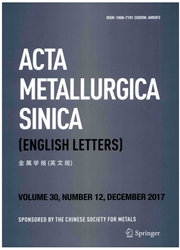

 中文摘要:
中文摘要:
The effect of surface roughness on the oxidation behavior of a directionally solidified Ni-based superalloy was investigated by surface mapping microscope,scanning electron microscope and X-ray diffraction.It was found that specimens with surface roughness of 0.05 urn exhibit the best oxidation resistance,while specimens with surface roughness of 0.14 μm behave worse than specimens with surface roughness of 0.83 μm.The specimens with surface roughness of 0.05 μm have the best oxidation resistance,which is mainly due to the smallest surface area exposed in air and thinnest work-hardening layer.The Al2O3 layer alleviates the oxidation process of the specimens with surface roughness of 0.83 μm,and this is the possible reason for the better oxidation resistance of samples with surface roughness of 0.83 μm than samples with surface roughness of 0.14 μm.
 英文摘要:
英文摘要:
The effect of surface roughness on the oxidation behavior of a directionally solidified Ni-based superalloy was investigated by surface mapping microscope,scanning electron microscope and X-ray diffraction.It was found that specimens with surface roughness of 0.05 urn exhibit the best oxidation resistance,while specimens with surface roughness of 0.14 μm behave worse than specimens with surface roughness of 0.83 μm.The specimens with surface roughness of 0.05 μm have the best oxidation resistance,which is mainly due to the smallest surface area exposed in air and thinnest work-hardening layer.The Al_2O_3 layer alleviates the oxidation process of the specimens with surface roughness of 0.83 μm,and this is the possible reason for the better oxidation resistance of samples with surface roughness of 0.83 μm than samples with surface roughness of 0.14 μm.
 同期刊论文项目
同期刊论文项目
 同项目期刊论文
同项目期刊论文
 Effect of Mo addition on microstructural characteristics in a Re-containing single crystal superallo
Effect of Mo addition on microstructural characteristics in a Re-containing single crystal superallo Effect of holes on the room temperature tensile behaviors of thin wall specimens with (210) side sur
Effect of holes on the room temperature tensile behaviors of thin wall specimens with (210) side sur The effect of surface roughness on the oxidation behavior of a directionally solidified Ni-based sup
The effect of surface roughness on the oxidation behavior of a directionally solidified Ni-based sup The deformation and the recrystallization initiation in the dendrite core and interdendritic regions
The deformation and the recrystallization initiation in the dendrite core and interdendritic regions Effect of solidification condition and carbon content on the morphology of MC carbides in directiona
Effect of solidification condition and carbon content on the morphology of MC carbides in directiona Effect of carbon content on the microstructure and creep properties of a 3rd generation single cryst
Effect of carbon content on the microstructure and creep properties of a 3rd generation single cryst Effect of skew angle of holes on the thermal fatigue behavior of a Ni-base single crystal superalloy
Effect of skew angle of holes on the thermal fatigue behavior of a Ni-base single crystal superalloy 期刊信息
期刊信息
